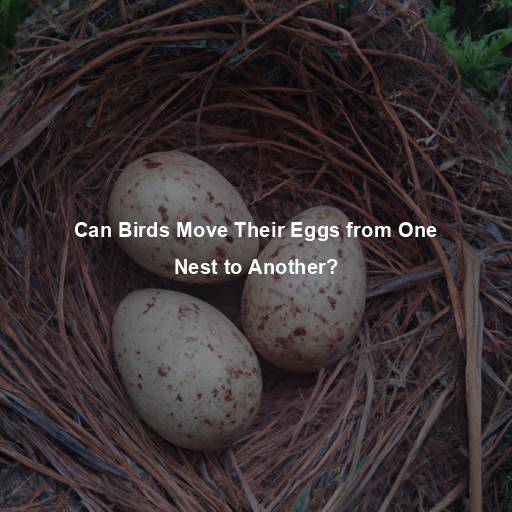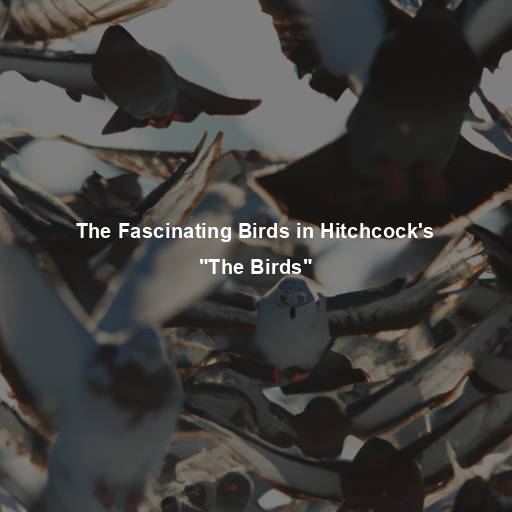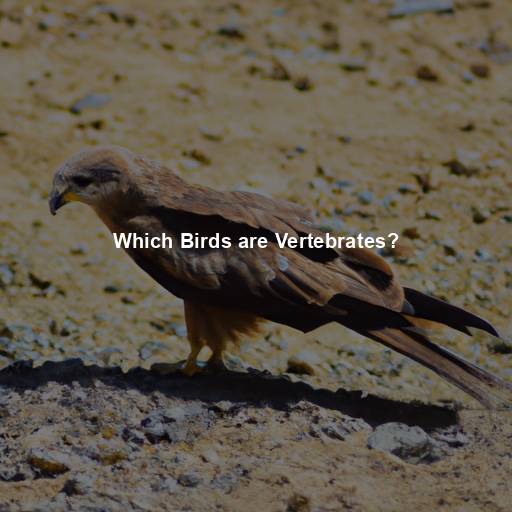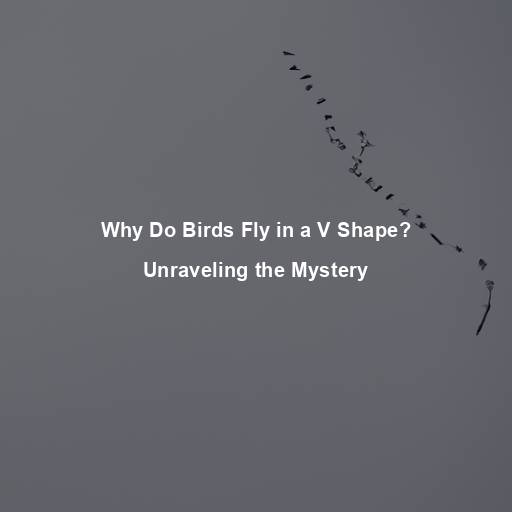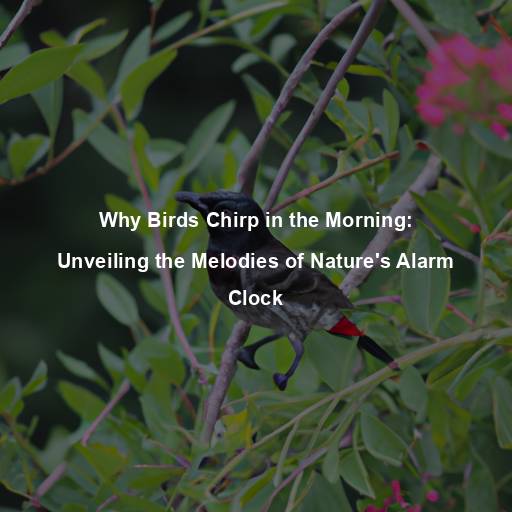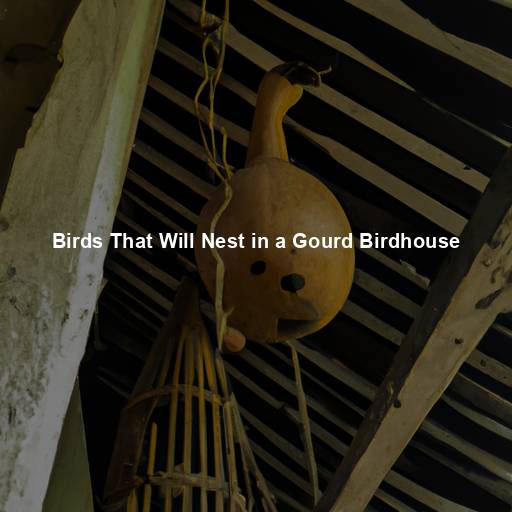Can Birds Move Their Eggs from One Nest to Another?
Last Updated on July 16, 2023 by Evan
Contents [hide]
- 1 Understanding the Nesting Behavior of Birds
- 1.1 The Importance of Nests for Birds
- 1.2 The Complexity of Bird Nests
- 1.3 The Role of Eggs in Nesting Behavior
- 1.4 The Challenges of Nest Abandonment
- 1.5 The Possibility of Egg Relocation
- 1.6 Evolutionary Constraints on Egg Relocation
- 1.7 Parental Investment and Recognition
- 1.8 Exceptions to the Rule
- 1.9 A Reflection of Instinct and Adaptation
- 1.10 Nest Construction: A Labor of Love
- 1.11 Nesting Sites: A Strategic Choice
- 2 Challenges to Nesting Success
- 3 Nest Abandonment and Egg Relocation
- 4 The Intricacies of Avian Parental Care
- 5 The Wonders of Avian Nesting Behavior
- 6 FAQs – Can Birds Move Their Eggs from One Nest to Another?
Understanding the Nesting Behavior of Birds
When we gaze upon the magnificent beauty of birds, our intrigue is sparked. Dazzling colors adorn their feathers, while their melodies enchant our ears. Yet, amidst this allure lies a perplexing puzzle – the enigma of their nesting habits. Nest building, an essential aspect of their existence, offers a sanctuary for their eggs and fledglings.
The Importance of Nests for Birds
Before we explore whether birds can move their eggs, it is essential to understand the significance of nests in the lives of these feathered creatures. Nests serve as a sheltered environment for birds to lay their eggs and raise their offspring. They provide protection from predators, inclement weather, and other environmental threats. Nests also offer a warm and comfortable space for incubating eggs, facilitating the embryonic development process.
The Complexity of Bird Nests
Bird nests, oh, what marvels they are! Their shapes, sizes, and materials vary so wildly, just as the bird species and their habitats do. Some birds fashion these intricate dwellings out of twigs, leaves, grass, and even bits of debris, while others opt for ready-made homes or cozy nooks in trees. It’s truly awe-inspiring to see the ingenious ways in which these feathered creatures create a safe haven for their precious offspring.
The Role of Eggs in Nesting Behavior
Eggs are the culmination of a bird’s reproductive process, representing the hope for the future generation. Birds invest significant time and energy in incubating their eggs, ensuring optimal conditions for successful hatching. The location of the nest plays a crucial role in regulating temperature and moisture levels necessary for the development of the embryos. Any disturbance to the nest can have profound effects on the viability of the eggs.
The Challenges of Nest Abandonment
In the world of feathered creatures, there exist moments of unexpected turmoil, where the unyielding forces of nature push them to make a perplexing decision – leaving their beloved nests behind. The reasons behind such avian abandonment are as diverse as the colors of their plumage: the menacing presence of predators lurking nearby, the disruptive interferences sprung upon them by humans or fellow creatures, or even the wrath of Mother Nature herself, unleashed in the form of severe weather tantrums. But alas, this act of relinquishing their precious abodes is no trifling matter for our avian friends, for it disrupts their delicate and dutiful reproductive pursuits, putting the precious survival of their cherished offspring in a state of precariousness.
The Possibility of Egg Relocation
Birds face a myriad of challenges when it comes to protecting their nests, leaving us to ponder if they possess the astonishing ability to relocate their precious eggs to safer surroundings. It may seem like a sensible strategy, but experts in the field assert that the majority of bird species do not engage in such egg-shuffling antics. This perplexing behavior can be attributed to a complex tapestry of factors, deeply ingrained in the evolutionary history of these avian marvels.
Evolutionary Constraints on Egg Relocation
Birds, fascinating creatures of the wild, have mastered the art of adaptation when it comes to their nests. With each species having its own unique preferences, they meticulously design and construct their nests to create the perfect sanctuary for their offspring. Such intricate planning ensures optimal conditions for incubation and the nurturing of their young. The prospect of relocating eggs to a different nest, however, poses a perplexing challenge, as it entails compelling physiological and behavioral transformations that are rarely witnessed in the avian realm.
Parental Investment and Recognition
The delicate intricacies of egg relocation are further compounded by the fascinating interplay of parental investment and recognition in avian species. As birds pour copious amounts of resources into constructing and nurturing their nests, it becomes evident that their commitment goes far beyond mere architecture. From the aromatic imprints to the markings left behind, these seemingly mundane cues serve as a vital compass for birds, distinguishing their own nest and eggs from others. Altering this intricate web of recognition through egg relocation would undoubtedly unsettle the delicate equilibrium, risking the unfortunate consequences of parental abandonment or rejection.
Exceptions to the Rule
It’s no secret that most birds prefer to keep their precious eggs in one place, but there are always a few rebels who like to shake things up. Take waterfowl, for example. Ducks and geese, those audacious creatures, may decide to take their eggs for a little stroll within their nesting neighborhood. Why, you might ask?
A Reflection of Instinct and Adaptation
Birds are truly fascinating creatures, especially when it comes to their nesting behavior. It’s mind-boggling how they instinctively know how to build their homes in a way that accommodates their reproductive needs and complements their surroundings. Just take a look at weaverbirds and their intricate nests, or ground-nesting birds that ingeniously create hidden burrows. The sheer diversity of nesting strategies among avian species is a testament to their remarkable ability to adapt and ensure the survival of their precious offspring.
Nest Construction: A Labor of Love
Building a nest is an intricate process that requires careful planning and meticulous execution. Birds exhibit remarkable architectural skills as they construct nests using a variety of materials. Some birds, like the bowerbird, create elaborate structures adorned with colorful objects to attract mates. Others, like the woodpecker, excavate cavities in trees to create safe nesting sites.
Nesting Sites: A Strategic Choice
Birds face a perplexing challenge when it comes to deciding where to build their nests. They must consider a myriad of factors, such as evading crafty predators, finding easy access to food, and creating a comfortable climate for their offspring. Yet, birds display an astonishing burst of intelligence by repeatedly returning to the same spot for their family affairs. This reveals their remarkable capacity to evaluate and remember the suitability of a nesting site, securing the legacy of their lineage for years to come.
Challenges to Nesting Success
Predation: A Constant Threat
One of the greatest challenges birds face during the nesting period is predation. Nest predation can occur from a variety of sources, including other animals, such as snakes or mammals, and even other birds. Nesting birds have evolved various strategies to minimize the risk of predation, such as choosing concealed nesting locations or engaging in aggressive behaviors to deter potential predators. However, despite these efforts, predation remains a significant threat to the survival of both eggs and nestlings.
Environmental Factors: A Battle against the Elements
Birds face a myriad of perplexing challenges when it comes to safeguarding their precious nests and eggs. From the capricious cloudbursts and tempestuous winds that can mercilessly ravage their delicate abodes, to the scorching heatwaves that threaten to reduce their fragile oases to ashes, the struggle is ceaseless. Alas, even the capricious hand of climate change ineluctably exacerbates these trials, thrusting avian communities into an intricate dance with fate. To prevail amidst these tumultuous times, adaptability and resilience must be their unwavering allies, lighting the path towards survival and triumph.
Human Interactions: An Anthropogenic Impact
As our world becomes increasingly intertwined, it is crucial to acknowledge the perplexing dance between human presence and avian nesting success. The fragile tapestry of nature is no stranger to the burstiness of our actions. Amidst the ever-growing urbanization, habitat destruction, and insidious use of pesticides, birds find themselves vulnerable, robbed of suitable nesting sites and vital food resources. Alas, the saga continues as human disturbances, in their ignorance or heedlessness, disrupt the delicate orchestration of avian reproductive efforts.
Nest Abandonment and Egg Relocation
A Last Resort: Nest Abandonment
Nest abandonment is a distressing event for birds, as it represents a significant investment of time and energy lost. While most birds do not relocate their eggs, they may resort to abandoning a nest under certain circumstances. Predation, nest parasites, or disturbances that compromise the safety of the nest can trigger this behavior. In such cases, birds may choose to start afresh and build a new nest in a different location to increase the chances of successful reproduction.
Limited Opportunities: Egg Relocation
In the intricate world of avian behavior, there exist peculiar instances where birds exhibit the astounding act of egg relocation. Astonishingly, certain species like the European starling go to great lengths by removing or even demolishing the eggs of their fellow feathered friends, thereby claiming their nests as their own. This remarkable behavior, politely referred to as nest usurpation, proves to be a resourceful ploy for the starlings, sparing them the efforts of constructing their own dwellings. Nonetheless, it is crucial to emphasize that this bewildering conduct stems from the fierce competition for limited nesting resources, rather than a conscious choice of relocating their precious brood.
The Waterfowl Exception
In the mesmerizing world of birds, waterfowl species have a knack for perplexing us with their extraordinary nesting habits. One particular habit that sets them apart is their unpredictable and almost bursty tendency to relocate their eggs. Take the majestic ducks and geese, for instance, who engage in an awe-inspiring routine of moving their precious eggs within their nesting grounds when things go awry. It’s a jaw-dropping sight to behold as they delicately grasp the eggs in their bills, like seasoned circus performers, and transport them to a nearby sanctuary where their chances of hatching and flourishing increase exponentially.
The Intricacies of Avian Parental Care
Incubation: A Delicate Balancing Act
Incubating eggs is a critical aspect of avian parental care. During this period, birds regulate the temperature and humidity of the nest to create optimal conditions for embryonic development. The parent birds take turns incubating the eggs, ensuring that each egg receives equal attention and warmth. This division of labor allows the parents to forage for food and maintain their own health while still providing the necessary care for their offspring.
Nestling Care: A Time of Nurturing
Once the eggs hatch, the focus shifts to the care of the nestlings. Parent birds tirelessly feed their hungry brood, often making multiple trips to gather insects, seeds, or small prey items. They also protect their young from predators and harsh weather conditions. As the nestlings grow, their demands increase, requiring the parents to provide more food and guidance.
The Wonders of Avian Nesting Behavior
A Testament to Adaptability
Birds, with their extraordinary knack for survival, constantly astound us with their diverse nesting habits. Look at how the dainty hummingbird crafts its charming cup-shaped abode, while the regal eagle effortlessly constructs a lofty eyrie atop a mighty tree. These avian architects have conquered the complexities of reproduction with ingenious adaptations. By delving into the captivating world of avian nesting behavior, we unveil a tapestry of natural marvels that leave us utterly mesmerized by the boundless wonders of existence.
FAQs – Can Birds Move Their Eggs from One Nest to Another?
Can birds move their eggs from one nest to another?
Yes, some bird species are known to occasionally move their eggs from one nest to another. This behavior is typically observed in birds that build more than one nest during their breeding season, such as ospreys, swallows, and some species of shorebirds. Moving eggs from one nest to another can have various reasons, such as avoiding predators, protecting the eggs from extreme weather conditions, or responding to disturbances in the original nest site.
How do birds move their eggs to a new nest?
When birds make the daring choice to relocate their precious eggs, nature has bestowed upon them the extraordinary gift of beaks. With delicate finesse, these avian marvels gingerly lift each fragile egg, cradling them in their meticulously crafted bill. Whether gliding through the skies or cautiously treading on land, these feathered architects determine the new nest site with an air of calculated precision, gently depositing their offspring into their sanctuary. It is through the remarkable adaptation of their beaks that these celestial beings navigate the perplexing task of transporting such fragile cargo, ensuring their safety and wellbeing, while captivating our imaginations with their ethereal grace.
Why do some birds move their eggs to a different nest?
Birds may move their eggs to a different nest for various reasons. One possible reason is to protect the eggs from predators. If a nest becomes compromised by a predator or is in an exposed location, birds may instinctively move their eggs to a safer spot to increase the chances of successful hatching. Additionally, extreme weather conditions, such as heavy rain or strong winds, can damage or flood a nest. In such cases, birds may relocate their eggs to ensure their survival and prevent them from being destroyed.
Is it common for birds to move their eggs?
While not all bird species engage in this behavior, it is relatively common among certain species that build multiple nests. For example, ospreys are well-known for moving their eggs between alternative nests as a way to safeguard them. Similarly, cliff-nesting birds like swallows often move their eggs to different sites if their original nest is disturbed or destroyed. However, the frequency of this behavior varies among species, and not all birds have the ability or need to move their eggs.
Can birds relocate eggs that have already hatched?
No, once the eggs have hatched and the chicks have emerged, birds do not typically move them to a different nest. This is because once the young birds have left the eggs, they become mobile and will eventually fledge from the nest. Parent birds focus their efforts on providing food and care to the chicks rather than moving them. However, in some cases where a nest is threatened or destroyed after hatching, the parent birds might relocate the chicks to a safer location nearby if they are still too young to fledge.

